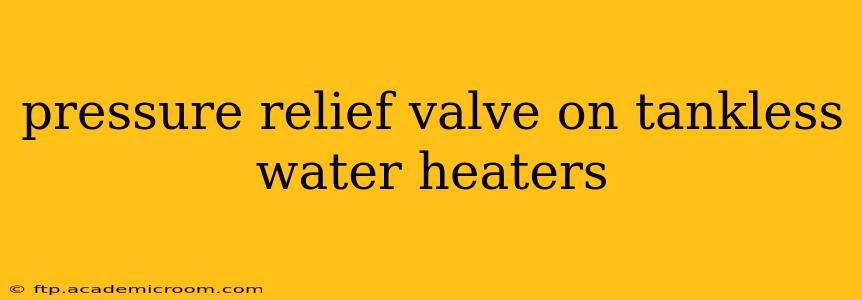Tankless water heaters, while offering endless hot water and energy efficiency, require understanding of their safety mechanisms. One crucial component is the pressure relief valve (PRV), often overlooked but vital for preventing potentially dangerous situations. This guide delves into the intricacies of the pressure relief valve on tankless water heaters, addressing common questions and concerns.
What is a Pressure Relief Valve (PRV) on a Tankless Water Heater?
A pressure relief valve (PRV) is a safety device designed to automatically release excess pressure from your tankless water heater. This pressure buildup can occur due to several factors, including overheating, excessive water pressure from the municipal supply, or a malfunction within the heater itself. The PRV acts as a pressure safety valve, preventing potentially catastrophic consequences like tank rupture or system failure. It's a crucial safety feature that protects both your property and your family. Think of it as a pressure release mechanism, ensuring the system stays within safe operating parameters.
How Does a Pressure Relief Valve Work on a Tankless Water Heater?
The PRV on a tankless water heater is typically a spring-loaded valve. When the pressure within the water heater exceeds a predetermined limit (usually around 150 PSI), the spring is overcome, and the valve opens, releasing hot water and pressure. This rapid pressure release prevents dangerous over-pressurization. It’s important to note that the released water will be extremely hot, so proper installation and placement are vital for safety. The valve is designed to reseal once the pressure returns to a safe level.
Why is the Pressure Relief Valve Important for Tankless Water Heaters?
The importance of a functioning PRV on a tankless water heater cannot be overstated. Its primary role is to prevent:
- System damage: Over-pressurization can cause cracks, leaks, or even complete failure of the water heater, leading to costly repairs or replacements.
- Scalding: High-pressure water can be forcefully ejected from any weak points, causing serious burns.
- Property damage: A burst water heater can lead to significant water damage to your home and belongings.
A properly functioning PRV minimizes these risks, offering peace of mind and protecting your investment.
How Often Should I Test My Tankless Water Heater's Pressure Relief Valve?
Testing your tankless water heater's PRV is recommended annually or as per the manufacturer’s instructions. This involves manually activating the valve lever (usually a small lever on the valve itself). This will release a small amount of hot water, confirming that the valve is functioning correctly. Always exercise caution when testing, as the water will be hot. Wear protective gear if necessary.
What Happens If My Pressure Relief Valve Leaks?
A leaking pressure relief valve indicates a problem. It could be due to:
- A faulty valve: The valve itself may be worn, damaged, or simply failing.
- High water pressure: Check your home's water pressure. If it's consistently high, it can put undue stress on the PRV.
- System issues within the water heater: A malfunctioning component within the heater could be causing pressure buildup.
A leaking PRV should be addressed immediately by a qualified plumber or appliance technician. Continuing to operate the water heater with a leaking PRV is unsafe.
What Should I Do If My Pressure Relief Valve Is Constantly Leaking?
A continuously leaking PRV is a serious issue requiring immediate attention. Do not attempt to repair the valve yourself. This persistent leakage signifies an underlying problem, possibly excessive water pressure or a malfunction within the water heater. Contact a qualified plumber or service technician to diagnose and resolve the root cause. Continuing to operate the unit with a constantly leaking PRV is unsafe and can cause significant damage.
Can I Replace the Pressure Relief Valve Myself?
While some homeowners are adept at DIY repairs, replacing a PRV is generally best left to a qualified technician. Improper installation can compromise safety, negating the purpose of the valve. A professional will ensure correct installation, pressure testing, and verification of the system's functionality after the replacement.
This guide offers valuable information on the pressure relief valve in tankless water heaters. Remember, regular inspection and maintenance are essential for ensuring the safety and longevity of your system. Always prioritize safety and consult a qualified professional when necessary.
